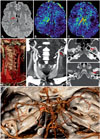Dear Editor,
Agenesis of the internal carotid artery (ICA) is a rare congenital malformation, with approximately 150 cases having been described.1 In rare cases it has been linked to seizures.23 We report a case of earlier-onset epilepsy in which the diagnosis of agenesis of ICA was incidentally performed during brain magnetic resonance imaging (MRI).
A 27-year-old male with slightly delayed psychological development was hospitalized due to an episode of short-term unconsciousness (about 1 min) followed by generalized seizures and delirium. Brain computed tomography (CT) and MRI showed slight asymmetry of the ventricles (Fig. 1A) and the absence of left ICA flow in its intracranial tract, which was confirmed by magnetic resonance angiography and Doppler ultrasound. Transcranial Doppler ultrasound showed hemodynamic compensation through the anterior communicating artery (ACoA) and posterior communicating artery (PCoA). Perfusion MRI showed asymmetric perfusion of the cerebral hemispheres with a high mean transit time in the right frontoparietal area (Fig. 1B and C). CT angiography confirmed the complete absence of the cervical and intracranial left ICA with the left common carotid artery continuing as an external carotid artery, hemodynamic compensation through the anterior and posterior circulations (Fig. 1D, E, and H), and also the absence of the bony carotid canal on the left side while the right carotid canal had developed normally (Fig. 1F and G).
The electroencephalogram (EEG) contained diffuse, bilateral, and synchronous spike-and-wave discharges. A neuropsychological survey performed with the WAIS-R scale highlighted cognitive alterations (his IQ was 45). The patient was started on carbamazepine (400 mg/day) and acetylsalicylic acid (100 mg/day).
The most-frequent pattern of collateral circulation in agenesis of the ICA is the fetal type, where the anterior cerebral artery is supplied by the contralateral ICA via the ACoA, and the middle cerebral artery receives basilar artery blood supplied by the PCoA.1 This situation results in most cases remaining asymptomatic for a long time.34
Various and inconstant symptoms such as headache, blurred vision, hearing loss, Horner's syndrome, and hypopituitarism are reported, as are cases of ischemic stroke, subarachnoid hemorrhage, transient global amnesia, and focal and generalized seizures.235 ICA dysgenesis can also present in PHACE syndrome, which is a rare pediatric condition.6
ICA agenesis is often diagnosed incidentally. Interest in this condition is mainly related to associated disorders such as malformations of the circle of Willis or pathological anastomosis associated with a risk of cerebrovascular events. The condition is easily diagnosed using noninvasive methods such as CT angiography, MRI, and perfusion MRI, which are useful for discovering organic causes in apparently idiopathic juvenile epilepsy.
The present case had an absent bone canal and fetal-type collateral circulation. Wang et al.2 described a similar case of a young child with partial epilepsy and absence of the left ICA and ipsilateral bony carotid canal in 1994. However, the clinical manifestation in our case was characterized by generalized seizures with diffuse EEG alterations and defective perfusion in the frontoparietal region. Indeed, there is increasing evidence that the frontal area plays a role in the generation of generalized spike-and-wave discharges.7
We suggest that the symptoms of the present patient were related to a brain perfusion disorder and played a role in the genesis of the mild mental retardation. We therefore recommend performing Doppler ultrasound and cerebral CT angiography in patients with idiopathic epilepsy and negative MRI findings.
Figures and Tables
Fig. 1
Axial fluid-attenuated inversion recovery MRI scan (A) showing no focal abnormalities in signal intensities within the brain. Note the mild asymmetry of the lateral ventricles (arrow). Perfusion dynamic susceptibility contrast MRI with MTT map (B and C) shows asymmetric perfusion of the cerebral hemispheres with a high MTT (green color) in the right frontoparietal area. CT angiography (E) with the VRT and maximum intensity projection (D) clearly shows the normal carotid artery bifurcation on the right side (asterisks) and the complete absence of the cervical and intracranial left internal carotid artery, with the left common carotid artery continuing as an external carotid artery (arrow). Axial CT scan with a bone algorithm at the skull base (F and G) shows that the bony carotid canal is absent on the left side (arrows) and has developed normally on the right side (asterisks). CT angiography with the VRT (H) shows normal flow in the left middle cerebral artery, supplied by a large posterior communicating artery (arrow). CT: computed tomography, MRI: magnetic resonance imaging, MTT: mean transit time, VRT: volume rendering technique.

References
1. Lie TA. Congenital anomalies of the carotid arteries: including the carotid-basilar and carotid-vertebral anastomoses. an angiographic study and review of the literature. Excerpta Medica. 1968; 35–41.
2. Wang PJ, Liu HM, Young C, Lin MY, Shen YZ. Agenesis of internal carotid artery associated with symptomatic partial epilepsy. Epilepsia. 1994; 35:1337–1341.

3. Campello-Morer I, Giménez-Muñoz Á, Guelbenzu S, Pérez-Trullén JM. Agenesis of the internal carotid artery in a patient with vascular pathology, epilepsy and transient global amnesia. Rev Neurol. 2011; 53:508–510.
4. Lee JH, Oh CW, Lee SH, Han DH. Aplasia of the internal carotid artery. Acta Neurochir. 2003; 145:117–125.

5. Cohen JE, Gomori JM, Leker RR. Internal carotid artery agenesis: diagnosis, clinical spectrum, associated conditions and its importance in the era of stroke interventions. Neurol Res. 2010; 32:1027–1032.





 PDF
PDF ePub
ePub Citation
Citation Print
Print


 XML Download
XML Download